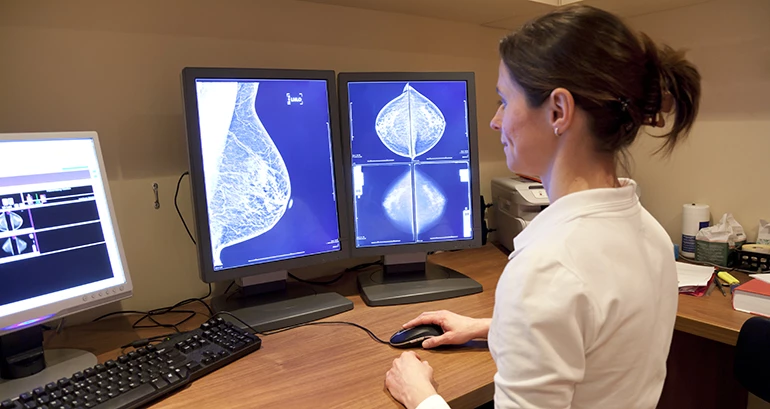Breast Cancer Types

Though every woman with breast cancer has a unique experience, researchers have identified major types of breast cancer to help us better understand the disease. Your doctor will find out what type of breast cancer you have in order to plan the best treatment for you.
Breast Cancer Classification
Doctors classify breast cancer primarily according to:
- Location: the part of the breast where it starts
- Spread: if and where the cancer has spread
You may also hear the term recurrent breast cancer, which means cancer that reappears after breast cancer treatment.
Types of Breast Cancer by Location
- Ductal breast cancer starts in the breast ducts—the parts of the breast where milk travels.
- Lobular breast cancer starts in the lobes of the breast—the parts responsible for milk production.
- Paget’s Disease starts in the nipple. It commonly comes with marked symptoms, including itching, burning and an eczema-like condition around the nipple, sometimes accompanied by oozing or bleeding.
- Phyllodes tumors are rare tumors that occur in the stroma, or connective tissue, of the breast. These tumors are more common in premenopausal women and can be benign (not cancerous) or cancerous.
- Inflammatory breast cancer occurs in the skin of the breast. Unlike other breast cancers, it frequently does not have a lump.
Types of Breast Cancer by Spread
- In situ refers to cancer that has remained in the tissue where it started. All of the types of breast cancer listed above can stay in situ. Ductal carcinoma in situ (DCIS) remains in the ducts, for example. Lobular carcinoma in situ (LCIS) remains in the lobules.
- Invasive cancers have moved out of breast ducts or lobules into nearby breast tissue. If in situ cancers begin to spread, doctors call them invasive. Once breast cancer has become invasive, it can move to other parts of the body, most commonly to the lymph nodes in the underarm (also called the axillary lymph nodes). The lymph nodes can provide an avenue for cancer to spread to other parts of the body.
- Metastatic breast cancer refers to cancer that started in the breasts but has moved to other parts of the body, beyond the breast and surrounding lymph nodes. You might also hear this called stage IV, mets or advanced breast cancer, though “advanced” can also describe stage III cancers. Metastatic breast cancer can feel especially overwhelming, but know that many women live long, productive lives after this diagnosis.
Recurrent Breast Cancer
Breast cancer sometimes returns after treatment, even when it seemed to have disappeared. Doctors call this recurrent breast cancer. Recurrent breast cancer can remain in situ, or it can spread.
- Local recurrence means breast cancer that returns to the same place it started.
- Regional recurrence means breast cancer that returns after treatment and appears in other, nearby, parts of the body.
- Distant recurrence means breast cancer that has returned and metastasized, meaning it has reappeared and spread to distant parts of the body. This can also be called metastatic or stage IV breast cancer.
Less Common Forms of Breast Cancer
Some other types of breast cancer you may hear about include:
- Colloid breast cancer, or mucinous breast cancer, a form of invasive ductal carcinoma that makes mucus and is typically less aggressive.
- Medullary breast cancer, rare and resembling the color of brain tissue (the medulla) under the microscope. It is usually triple negative, more common in women with a BRCA mutation and less likely to involve the lymph nodes.
- Tubular breast cancer, a type of invasive ductal carcinoma made up of tube-like structures. It tends to be small and slow-growing.
Receptor Status and Triple Negative Breast Cancer
Your pathology report and your healthcare providers may describe your breast cancer as estrogen receptor (ER), progesterone receptor (PR) or human epidermal growth factor receptor-2 (HER2) positive or negative. Or, they may say that your breast cancer is triple negative or triple positive.
Estrogen and progesterone receptors (also called hormone receptors) are proteins found in some cancer cells that allow a hormone (estrogen, progesterone or both) to attach and “feed” the cancer cells. Hormone receptor status is reported as positive or negative and sometimes a percent is also provided. For example, 90% estrogen receptor positive. ER/PR+ breast cancers will, at a minimum, receive some form of hormone therapy such as Tamoxifen.
HER2 is a protein involved in normal cell growth, which may also be present on breast cancer cells. If too much of the HER2 protein is produced, the tumor is considered HER2+ (also called ERBB2). Breast cancers that are HER2+ will receive HER2 directed therapy such as Herceptin.
Triple positive breast cancer is positive for HER2, ER and PR. You will receive HER2 directed therapies as well as hormone therapy.
Triple negative breast cancer is negative for HER2, ER and PR. Therefore, HER2 directed therapy and hormone therapy are not utilized. Typical treatment is chemotherapy.
Preliminary information about your cancer’s type will come from a biopsy and imaging tests such as ultrasounds, mammograms and MRIs. More specific answers can come from your pathology report. Your doctor will also describe your cancer in more detail when you discuss breast cancer stages.


